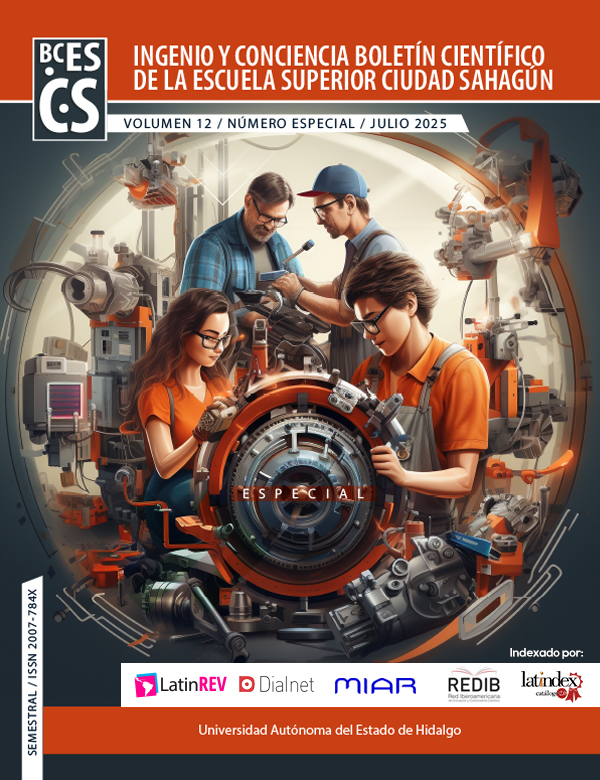Borurización
DOI:
https://doi.org/10.29057/escs.v12iEspecial.15282Palabras clave:
Borurización, carburación, nitruración, PVDResumen
La boruración es un tratamiento termoquímico de superficies que implica la difusión de boro en una base metálica, de forma muy similar a la carburación y la nitruración. Para llevar a cabo este proceso, el sustrato debe estar en contacto con una sustancia rica en boro (Disponible en forma de polvo sólido, pasta, líquido o gas) y mantenerse a altas temperaturas, que suelen oscilar entre los 700 y los 1200ºC. Durante este calentamiento, los átomos de boro se desplazan desde la superficie a la red metálica, interactuando con los átomos del metal y cualquier elemento de aleación para crear boruros. Esta interacción conduce al desarrollo de una capa borurada. Además, pueden utilizarse técnicas de lecho fluidizado para la boruración. Entre los métodos alternativos para lograr la deposición de capas de boruro sin depender de la activación termoquímica se incluyen la deposición de vapor de plasma (PVD), la implantación de iones y las técnicas de pulverización de plasma.
Descargas
Información de Publicación
Perfiles de revisores N/D
Declaraciones del autor
Indexado en
- Sociedad académica
- N/D
Citas
Allaoui, O., Bouaouadja, N., & Saindernan, G. (2006). Characterization of boronized layers on a XC38 steel. Surface and Coatings Technology, 201(6), 3475-3482. doi:https://doi.org/10.1016/j.surfcoat.2006.07.238
Bartsch, K., & Leomhardt, A. (1999). Formation of iron boride layers on steel by d.c.-plasma boriding and deposition processes. Surface and Coatings Technology, 116-119, 386-390. doi:https://doi.org/10.1016/
Bortec. (7 de Julio de 2017). bortec.de. Obtenido de Bortec: https://bortec.de/en/boronizing/
Chernov, Y. B., Anfinogenov, A. I., & Veselov, I. N. (1999). Special features of the technology of boronizing steel in a calcium chloride melt. Metal Science and Heat Treatment, 41, 511-515. doi:https://doi.org/10.1007/BF02466541
Curtis, D., (1993). Case hardening nickel alloys, Mater. Design 14(6), 349–350.
Dearnley, P.A., Bell, T., (1985). Surf. Eng. 3, 203–217.
Fichtl, W., (1981). Boronizing and its practical applications, Mater. Eng. 2, 276–286.
Galibois, A., Boutenko, O., Voyzelle, B., (1980). Me´canisme de Formation des Couches Borure´es Sur Les Aciers a Haut. Carbone-II – Technique des Poudres. Acta Metall. 28, 1765–1771
Golpalakrishnan, P., Ramakrishanan, S. S., Shankar, P., & M., P. (2002). Interrupted boriding of medium-carbon steels. Metallurgical and Materials Transactions A, 1475–1485. doi:https://doi.org/10.1007/s11661-002-0070-0
Kaestner, P., OlFe, J., & Rie, K.-T. (2001). Plasma-assisted boriding of pure titanium and TiAl6V4. Surface and coatings Technology, 142-144, 248-252. doi:https://doi.org/10.1016/S0257-8972(01)01244-0
Kulka, M. (2019). Current Trends in Boriding Techniques. Poznan, Poland: Springer. doi:https://doi.org/10.1007/978-3-030-06782-3
Kulka, M., Makuch, N., PerteK, A., & Maldzinski, L. (2013). Simulation of the growth kinetics of boride layers formed on Fe during gas boriding in H2-BCl3 atmosphere. Journal of Solid State Chemistry, 199, 196-203. doi:https://doi.org/10.1016/j.jssc.2012.12.029
Makuch, N., Kulka, M., & Mikołajczak, D. (2017). Corrosion Behavior of Hard Boride Layer Produced on Nimonic 80A-Alloy by Gas Boriding. Transactions of the Indian Institute of Metals, 2059-2527. doi:https://doi.org/10.1007/s12666-017-1113-y
Martini, C., Palombarini, G., (2004). Mechanism of thermochemical growth of iron borides on iron, J. Mater. Sci. 39, 933–937.
Morales-Robles, Á.J.; Ortiz-Domínguez, M.; Gómez-Vargas, O.A.; Moreno-González, M.d.l.L., (2024) Boronize Coatings Studied with a NewMassTransfer Model. Materials, 17, 5309. https://doi.org/ 10.3390/ma17215309
Ortiz-Domínguez, M.; Morales-Robles, Á.J.; Gómez-Vargas, O.A.; Moreno-González, G., (2024). Surface Growth of Boronize Coatings Studied with Mathematical Models of Diffusion. Metals, 14, 670. https://doi.org/10.3390/ met14060670
Ortiz-Domínguez, M.; Gómez-Vargas, O.A.; Bárcenas-Castañeda, M.; Castellanos-Escamilla, V.A., (2022). Comparison andAnalysis of Diffusion Models: Growth Kinetics of Diiron Boride Layers on ASTMA283Steel. Materials, 15, 8420. https:// doi.org/10.3390/ma15238420
Ortiz-Domínguez, M., Morales-Robles, Á., Gómez-Vargas, O., & Solís-Romero, J. (2020). Recycling of the powder-pack boriding mixture: Microstructural characterization of Fe2B Layers on ASTM A36 Steel. Microscopy and Microanalysis, 26(S2), 2220-2222. doi:10.1017/S143192762002084X
Petrova, R.S., Suwattananont, N., (2005). Surface modification of ferrous alloys with boron, J. Electron. Mater. 34(5), 575–582.
Petrova, R.S., Suwattananont, N., Samardzic, V., (2007). The effect of boronizing on metallic alloys for automotive applications, J. Mater. Eng. Perform. 31, 1059–9495, ASM International
Sen, S., Sen, U., Bindal, C., (2005). The growth kinetics of borides formed on boronized AISI 4140. VACUUM – Surf. Eng. Surf. Instrum. Vac. Technol. 77, 195–202.
Sinha, A.K., (1991). Metals Handbook- Heat Treating-Boriding (boronizing) of Steels, vol. 4 (ASM International, Materials Park), pp. 978–999
Stewart, K., (1997). Boronizing protects metals against wear. Adv. Mater. Process. 3, 23–25
Descargas
Publicado
Cómo citar
Número
Sección
Licencia
Derechos de autor 2025 Martín Ortiz Domínguez, Arturo Cruz Avilés, Isaías Simón Marmolejo

Esta obra está bajo una licencia internacional Creative Commons Atribución-NoComercial-SinDerivadas 4.0.



















